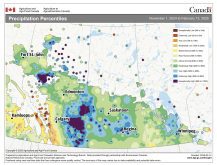The market gives and the market takes away.
But for a few years it has been, and probably will continue to be for years to come, more of a taker than a giver.
That means farmers must learn how to take advantage of bear market rallies.
They must also learn from the oil industry, which is living that reality in a stark way today.
Look at the chart here. That’s a pretty shocking plunge and it’s creating mayhem among oil producers and those who rely upon them, including governments.
Read Also

USDA’s August corn yield estimates are bearish
The yield estimates for wheat and soybeans were neutral to bullish, but these were largely a sideshow when compared with corn.
(This is separate from the situation I talked about last week, with the spread between West Texas Intermediate and oilsands crude revealing the dangers that transportation system failures can bring. This isn’t a system failure, just a regular old situation of oversupply.)
The oil rally this year was surprising, because it was profound and sustained. I had trouble getting my head around why everybody was suddenly so bullish, after having been bearish for years. But there were some reasons to believe that global growth was picking up and supplies weren’t going to drown it. I heard these arguments numerous times on Bloomberg radio and read them in financial newspapers.
But the bullish argument never seemed that well-grounded, especially in a world in which turning on the taps and pouring out shale oil has been proven to be very easy to do any time prices pick up.
“Shale Boom Raises Specter of Gulf Coast Oil Terminal Glut,” said one Bloomberg headline on Nov. 26.
That’s not a great basis for a bull market. Of course, it’s always hard to know what’s noise and what’s the underlying truth.
Here’s another Bloomberg headline that ran right beneath the one above:
“Goldman Predicts Commodities Will Soar in ’19.”
It can be a little confusing, can’t it?
But if you step back and look at a situation of OK growth in the United States, weak growth in Canada, the European Union being always one step away from another economic crisis, China slowing and developing nations struggling, you have to ask yourself how strong and long any overall commodity market rally is going to be. Apply that to the crop markets. For whatever the weather does to various crops around the world, short of a major wreck somewhere, demand is going to be key.
That brings up all the factors that seem to be behind the slump in oil, and is probably the biggest underpinning to today’s weakness in crop prices. There just isn’t that ravenous desire among the world’s people to consume more. Any hints of oversupply knock the legs out from under the market.
The rallies we’ve seen, and probably will see for a few more years, are likely to be bear market rallies. They’re able to take off on ideas and rumours of tightening supplies, and can push prices well above lows, but they don’t last. They’re mostly bits of momentary madness that break out when people get tired of being pessimistic.
They’re selling opportunities, not a reason to get comfortable and complacent about good prices being back again.
Learning how to use these rallies to price crop in generally discouraging times was something that let a lot of farmers survive the last low-price patch of the pre-2006 world. Those are skills people need to be using today, as the recent selloffs have shown us.

















